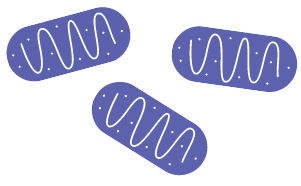The mitochondria
Mitochondria are the power plants of our cells. Each human cell contains many mitochondria, typically many hundreds to thousands. Each of these mitochondria produces the molecule "ATP", which is the body's universal energy store.
As an electric car repeatedly charges its battery and then uses the battery's energy to drive, so the mitochondria produce the ATP, which in turn all the cells of the body then use to power their cellular processes. 90% of the energy used by the body is produced by the mitochondria. Without mitochondria, there would be no life as we know it.
Mitochondria are present in particularly large numbers in cells that have a high energy demand. These are in particular muscle cells, such as those of the heart, nerve cells, such as those of the brain, and sensory cells, such as those of the eye.
Furthermore, in addition to energy production, mitochondria also play a major role in a number of important regulatory processes in cells.

Mitochondrial Diseases
Just like an engine with many parts, many parts in the mitochondrial machinery can break down. The cause of this almost always lies in the genes that contain the blueprint of the mitochondria. If the blueprint contains a small error or a piece of the blueprint is missing, the body, simply put, does not assemble the mitochondria quite right. More than 200 different genetic errors are now known to occur in nature. The DNA and the genes of the mitochondria find themselves in two places: Part of the DNA is resides in the nucleus of a cell, where almost all of the human DNA is located. A very small part of the DNA is located in the mitochondria themselves.
Errors in the blueprint of the mitchondria have one main effect: the cells generate less energy (ATP) than those of other people. In the analogy of the electric car, a person with mitochondrial disease can never fully charge his or her battery. This leads to problems whenever a lot of energy is needed. This is the case, for example, when having the flu. During the flu, the body mobilizes the immune system and heats up the body ("fever"). Both processes consume a lot of energy. The problem: if the energy available to a cell falls below a critical threshold, the cell dies ("apoptosis"). Therefore, flu-like infections can have very severe consequences for patients with mitochondrial diseases, as cells with an increased energy demand can be damaged or even die.
However, mitochondria are also involved in a number of other processes important to the body besides energy production, such as transmitting signals between cells and controlling the negative effects of oxygen. Mitochondrial diseases can also have an impact here, the effects of which are not fully understood today. The more than 200 known gene mutations in mitochondria can therefore lead to very different visible signs of disease (phenotypes) in patients.
Clear cause, many different symptoms
In contrast to many widespread diseases such as cancer or depression, which have many and sometimes still unknown causes, research into mitochondrial diseases offers a major advantage: the cause, which is usually genetic, can often be diagnosed precisely. However, the symptoms are all the more different. Mitochondrial diseases can lead to dysfunctions in almost any organ, from the brain to muscles, nerves, heart, kidney, pancreas and sensory organs. This does not mean that every patient will have all of these symptoms. Many patients have symptoms in very few organs. It shows much more the importance that mitochondria have on our organism.
Much of the research therefore lies in understanding mechanisms of action: In which processes and regulatory circuits are mitochondria involved? How are they disrupted by a mutation in a particular area? What effects results from this? Which 'levers' can therefore be used for therapy?
